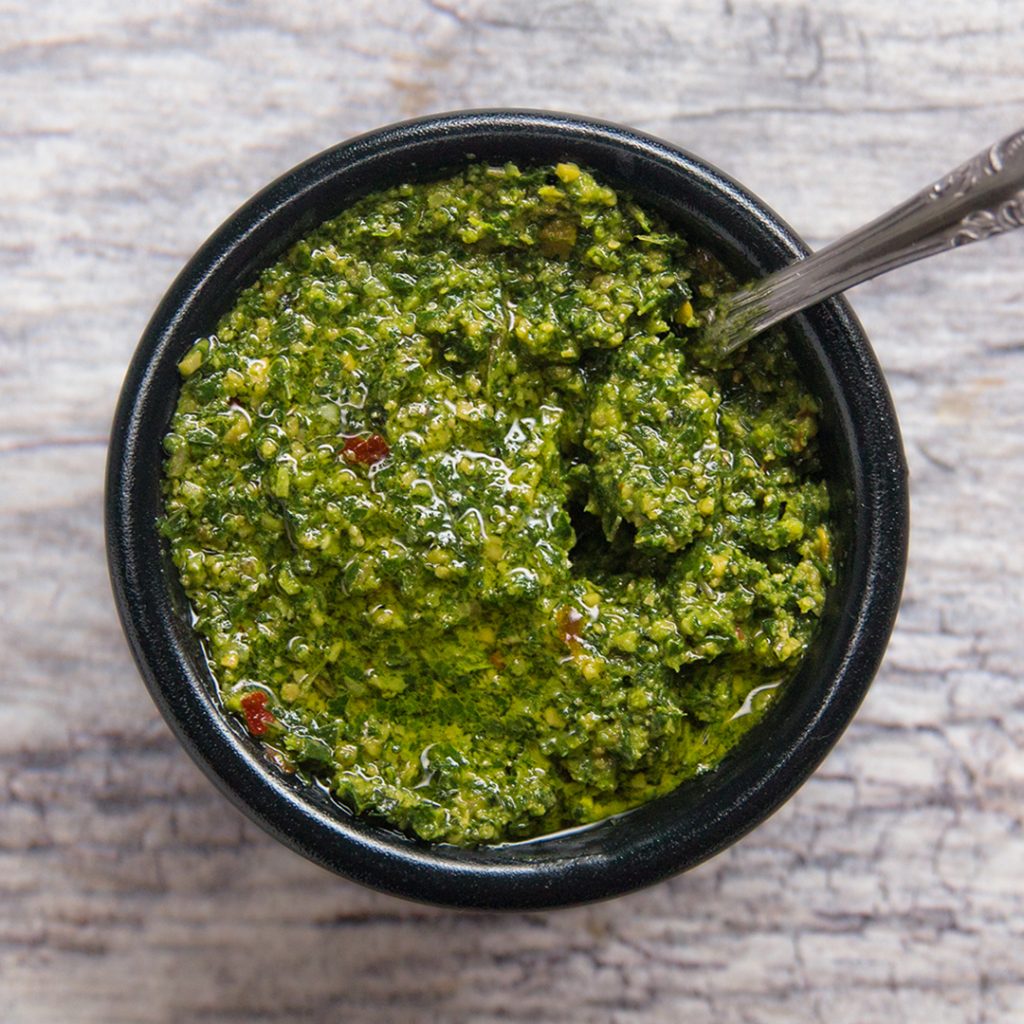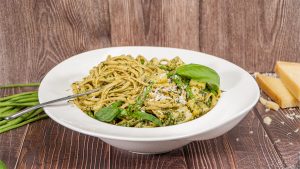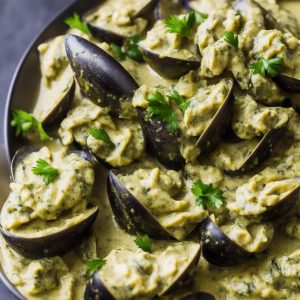This flavorful Thai Basil Peanut Pesto is not your ordinary pesto. It's a fusion recipe that combines traditional Italian concept with the bold Thai flavors. The use of Thai basil, sesame oil, and peanuts makes it a unique addition to any dish.

While most ingredients in this recipe are quite common, Thai basil might not be something you regularly have at home. It's a type of basil native to Southeast Asia that has a unique anise, licorice-like flavor. You can find this herb in most Asian grocery stores or well-stocked supermarkets.
Ingredients for Thai Basil Peanut Pesto
Thai basil leaves: Thai basil stands out from its Italian counterpart with its purple stems and potent flavor, offering a unique twist to the pesto.
Garlic cloves: Garlic adds a spicy, warm depth to the sauce.
Peanuts: Peanuts provide a wonderful crunch and earthy flavor, deviating from the traditional pine nuts used in pesto.
Sesame oil: Sesame oil gives our pesto a rich, nutty flavor that pairs well with the Thai basil and peanuts.
Rice vinegar: Rice vinegar contributes a delicate acidic touch, vital for balancing out the flavors.
Red pepper flakes: These add a bit of heat, but can be adjusted according to your spice preference.
Agave nectar: Agave nectar is a natural sweetener that helps round off the heat and acidity.
Soy sauce: Soy sauce adds umami flavor and some saltiness to the pesto.
Lime juice: Lime juice adds a bright, citrusy tang that lifts up the overall flavor profile.
Salt: Salt enhances all the other flavors in the pesto.
One reader, Averyl Dockery says:





This Thai basil peanut pesto recipe is a game-changer! The flavors are so vibrant and the texture is perfect. It's incredibly versatile and adds a delicious twist to any dish. I love how easy it is to make, and the aroma is simply divine. It's a must-try for all food enthusiasts!
Techniques Required for Thai Basil Peanut Pesto Recipe
How to prepare the Thai basil peanut pesto: This involves combining the Thai basil leaves, garlic, peanuts, sesame oil, rice vinegar, red pepper flakes, agave nectar, soy sauce, and lime juice in a food processor and blending until smooth.
How to adjust the seasoning: After blending the pesto, taste and adjust the salt to your preference.
How to serve the pesto: The pesto can be served over pasta or used as a flavorful sauce for various dishes.
How To Make Thai Basil Peanut Pesto
Level up your dishes by whipping up this rich pesto recipe! Grind up some fresh Thai basil, garlic, and peanuts for a delicious sauce over meals.
Serves:
Ingredients
- 2cupsthai basil leaves,packed
- 4garlic cloves
- ¼cuppeanuts,dry roasted
- 3tbspsesame oil
- 1½tbsprice vinegar
- ½tspred pepper flakes
- 1tbspagave nectar
- 1tspsoy sauce
- 1tbsplime juice
- salt,to taste
Instructions
-
Place the Thai basil, garlic, peanuts, sesame oil, rice vinegar, red pepper flakes, agave nectar, soy sauce, and lime juice in the bowl of a food processor. Purée until smooth.
-
Add salt to taste. Use pesto immediately or transfer to an airtight container.
-
Serve over pasta, and enjoy!
Recipe Notes
Pesto can be stored in the refrigerator for up to two weeks.
Nutrition
- Calories: 667.97kcal
- Fat: 59.20g
- Saturated Fat: 8.12g
- Monounsaturated Fat: 25.16g
- Polyunsaturated Fat: 22.94g
- Carbohydrates: 28.77g
- Fiber: 5.38g
- Sugar: 17.20g
- Protein: 12.23g
- Sodium: 468.67mg
- Calcium: 145.78mg
- Potassium: 495.81mg
- Iron: 3.52mg
- Vitamin A: 132.13µg
- Vitamin C: 17.13mg
Technique Tip for Thai Basil Peanut Pesto Recipe
When making your Thai basil peanut pesto, it's important to add the oil gradually while the food processor is running. This will help to emulsify the ingredients and create a smooth, creamy pesto. Also, remember to scrape down the sides of the bowl occasionally to ensure all ingredients are well incorporated. If your pesto is too thick, you can add a little bit of water to reach your desired consistency.
Time-Saving Tips for Thai Basil Peanut Pesto
Prep ahead: Chop and measure all ingredients in advance to streamline the cooking process.
One-pot wonders: Opt for recipes that require minimal dishes for easy cleanup.
Batch cooking: Make a larger quantity and freeze individual portions for quick and convenient meals later.
Efficient tools: Utilize kitchen gadgets like food processors and immersion blenders to speed up prep and cooking.
Organized workspace: Keep your kitchen tidy and organized to minimize time spent searching for ingredients and utensils.
Quick cooking methods: Choose recipes that involve fast cooking techniques such as stir-frying or grilling for time efficiency.
Substitute Ingredients For Thai Basil Peanut Pesto Recipe
Thai basil leaves - Substitute with Italian basil: Italian basil has a similar flavor profile to Thai basil and can be used as a substitute in pesto recipes.
Peanuts - Substitute with Cashews: Cashews have a similar creamy texture and mild nutty flavor, making them a suitable replacement for peanuts in pesto.
Sesame oil - Substitute with Peanut oil: Peanut oil has a similar nutty flavor and high smoke point, making it a good substitute for sesame oil in this recipe.
Rice vinegar - Substitute with White wine vinegar: White wine vinegar can provide a similar level of acidity and tanginess to the pesto as rice vinegar.
Agave nectar - Substitute with Honey: Honey can add a touch of sweetness to the pesto, similar to agave nectar.
Soy sauce - Substitute with Tamari: Tamari is a gluten-free alternative to soy sauce and can provide a similar umami flavor to the pesto.
Lime juice - Substitute with Lemon juice: Lemon juice can provide the same level of acidity and citrusy flavor to the pesto as lime juice.
Presenting Thai Basil Peanut Pesto
Elevate the plating: Arrange the pasta in a nest shape on the plate, creating a visually appealing presentation.
Garnish with Thai basil leaves: Place a few fresh Thai basil leaves on top of the pesto pasta for a pop of color and a burst of fresh aroma.
Drizzle with sesame oil: Use a fine drizzle of sesame oil around the edge of the plate for an elegant touch and a hint of nutty flavor.
Sprinkle crushed peanuts: Sprinkle a small amount of crushed peanuts over the pasta for added texture and a delightful crunch.
Serve on a white, minimalist plate: Present the dish on a clean, white plate to allow the vibrant colors of the pesto and garnishes to stand out.
Essential Tools for Making Thai Basil Peanut Pesto
Food processor: A food processor is a versatile kitchen appliance that can be used to blend, chop, grind, and puree ingredients. It is perfect for making pesto, as it can quickly and efficiently process the basil, garlic, and peanuts into a smooth paste.
Mixing bowl: A mixing bowl is essential for combining the ingredients for the pesto. It provides a convenient and spacious vessel for mixing the thai basil, garlic, peanuts, and other flavorings together.
Storing and Freezing Thai Basil Peanut Pesto
To store the thai basil peanut pesto, transfer it to an airtight container or jar. Press a piece of plastic wrap directly onto the surface of the pesto to prevent oxidation and discoloration. Seal the container tightly and refrigerate for up to 1 week.
For longer storage, freeze the pesto in ice cube trays. Once frozen, pop out the pesto cubes and transfer them to a freezer-safe bag or container. Label the bag with the date and contents. Frozen pesto will keep for up to 6 months.
When ready to use the frozen pesto, remove the desired number of cubes and thaw them in the refrigerator overnight or at room temperature for a few hours. You can also add the frozen cubes directly to hot pasta or soups, allowing them to melt and incorporate into the dish.
If the pesto appears dry or thick after thawing, you can revive it by stirring in a little extra sesame oil or olive oil to achieve the desired consistency.
To maintain the best flavor and quality, avoid repeatedly freezing and thawing the pesto. Portion it out into smaller quantities before freezing to allow for easy use in single servings.
How To Reheat Leftover Thai Basil Peanut Pesto
To reheat leftover thai basil peanut pesto, start by placing the desired amount in a microwave-safe bowl. Cover the bowl with a damp paper towel to prevent the pesto from drying out during the reheating process. Microwave on high for 30-second intervals, stirring between each interval, until the pesto is heated through and reaches your desired temperature.
Another method for reheating thai basil peanut pesto is to use a double boiler. Fill the bottom of the double boiler with water and bring it to a simmer. Place the pesto in the top part of the double boiler and stir occasionally until it's heated through. This gentle heating method helps preserve the delicate flavors of the thai basil and peanuts while preventing the pesto from burning or drying out.
If you prefer a more rustic approach, you can reheat the thai basil peanut pesto in a skillet over low heat. Add a small amount of sesame oil or water to the skillet to prevent sticking and to help loosen up the pesto. Stir the pesto constantly while heating to ensure even warming and to prevent burning. Once the pesto is heated through, remove it from the heat and serve immediately.
For a quick and easy method, you can also reheat the thai basil peanut pesto by running it under hot water. Place the pesto in a sealed plastic bag and submerge it in a bowl of hot water. Knead the bag occasionally to ensure even heating. Once the pesto is warmed to your liking, remove it from the water, snip off a corner of the bag, and squeeze the pesto out onto your dish.
Random Fact About Thai Basil Peanut Pesto
The Thai basil peanut pesto is a versatile sauce that can be used in various dishes, such as pasta, sandwiches, and salads. It adds a unique and flavorful twist to traditional pesto recipes, thanks to the combination of Thai basil, peanuts, and sesame oil. This pesto is also a great source of plant-based protein and healthy fats, making it a nutritious addition to your meals. Additionally, Thai basil is known for its aromatic and slightly spicy flavor, which sets this pesto apart from the classic Italian version. Enjoy experimenting with this pesto in your favorite dishes!
Is Making Thai Basil Peanut Pesto at Home Economical?
The cost-effectiveness of this Thai basil peanut pesto recipe is quite favorable. The main ingredients, such as Thai basil and peanuts, are generally affordable and readily available. The addition of sesame oil and rice vinegar may slightly increase the cost, but these are versatile ingredients that can be used in various dishes. Overall, this recipe offers a good balance of cost and flavor. On a scale of 1-10, I would rate it an 8 for its affordability and delicious taste. The approximate cost for a household of 4 people is around $10-$12, making it a budget-friendly choice.
Is Thai Basil Peanut Pesto Healthy or Unhealthy?
This Thai basil peanut pesto recipe is a delicious and flavorful condiment that offers some health benefits, but it also has room for improvement. Let's break it down:
Healthy aspects:
- Thai basil is rich in antioxidants and anti-inflammatory compounds
- Garlic contains allicin, which has antimicrobial and immune-boosting properties
- Peanuts provide healthy fats, protein, and fiber
- Sesame oil contains heart-healthy monounsaturated fats
- Lime juice is a good source of vitamin C
Less healthy aspects:
- The recipe is high in oil, which can contribute to excessive calorie intake
- Agave nectar, while a natural sweetener, is still high in sugar
- Soy sauce contains a significant amount of sodium
To make this recipe even healthier, consider the following suggestions:
- Reduce the amount of sesame oil to lower the overall calorie content
- Replace agave nectar with a small amount of honey or omit the sweetener altogether
- Use low-sodium soy sauce or replace it with coconut aminos for a lower-sodium alternative
- Increase the amount of Thai basil to boost the antioxidant content
- Add more peanuts or replace them with almonds for an extra boost of healthy fats and fiber
- Incorporate additional vegetables, such as spinach or kale, to increase the nutrient density of the pesto
By making these adjustments, you can enhance the nutritional value of the Thai basil peanut pesto while still maintaining its delicious taste. Experiment with different variations to find the perfect balance that suits your health goals and taste preferences.
Editor's Thoughts on This Thai Basil Peanut Pesto Recipe
This Thai basil peanut pesto recipe is a delightful fusion of flavors. The aromatic Thai basil, crunchy peanuts, and zesty lime juice create a harmonious blend that will elevate any dish. The use of sesame oil and soy sauce adds depth, while the hint of heat from the red pepper flakes balances the sweetness of the agave nectar. This pesto is versatile and can be used as a sauce for pasta, a marinade for grilled meats, or a flavorful dip. It's a perfect way to add a touch of Thai-inspired flair to your culinary creations.
Enhance Your Thai Basil Peanut Pesto Recipe with These Unique Side Dishes:
Alternative Recipes Similar to Thai Basil Peanut Pesto
Appetizers and Desserts to Complement Thai Basil Peanut Pesto
Why trust this Thai Basil Peanut Pesto Recipe:
This recipe is a delightful fusion of traditional Thai flavors and the rich, aromatic essence of Thai basil. The combination of peanuts and sesame oil adds a delightful nuttiness, while the touch of rice vinegar and lime juice provides a perfect balance of acidity. The addition of agave nectar lends a subtle sweetness, harmonizing with the savory notes of soy sauce. With the perfect blend of ingredients, this pesto promises to elevate any dish, ensuring a memorable culinary experience.
Was this page helpful?
Have your own special recipe to share? Submit Your Recipe Today!














